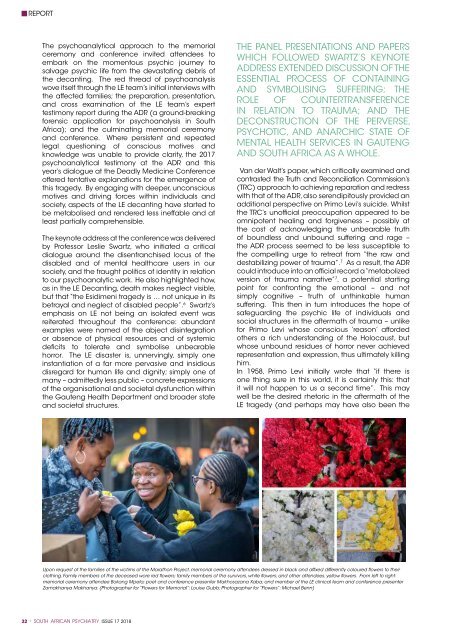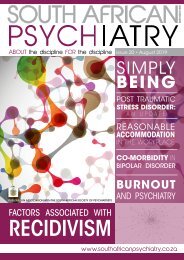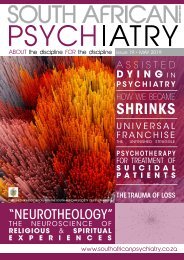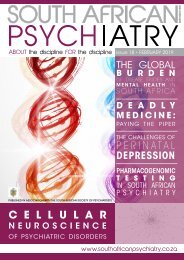South African Psychiatry - November 2018
South African Psychiatry - November 2018
South African Psychiatry - November 2018
Create successful ePaper yourself
Turn your PDF publications into a flip-book with our unique Google optimized e-Paper software.
REPORT<br />
The psychoanalytical approach to the memorial<br />
ceremony and conference invited attendees to<br />
embark on the momentous psychic journey to<br />
salvage psychic life from the devastating debris of<br />
the decanting. The red thread of psychoanalysis<br />
wove itself through the LE team’s initial interviews with<br />
the affected families; the preparation, presentation,<br />
and cross examination of the LE team’s expert<br />
testimony report during the ADR (a ground-breaking<br />
forensic application for psychoanalysis in <strong>South</strong><br />
Africa); and the culminating memorial ceremony<br />
and conference. Where persistent and repeated<br />
legal questioning of conscious motives and<br />
knowledge was unable to provide clarity, the 2017<br />
psychoanalytical testimony at the ADR and this<br />
year’s dialogue at the Deadly Medicine Conference<br />
offered tentative explanations for the emergence of<br />
this tragedy. By engaging with deeper, unconscious<br />
motives and driving forces within individuals and<br />
society, aspects of the LE decanting have started to<br />
be metabolised and rendered less ineffable and at<br />
least partially comprehensible.<br />
The keynote address at the conference was delivered<br />
by Professor Leslie Swartz, who initiated a critical<br />
dialogue around the disenfranchised locus of the<br />
disabled and of mental healthcare users in our<br />
society, and the fraught politics of identity in relation<br />
to our psychoanalytic work. He also highlighted how,<br />
as in the LE Decanting, death makes neglect visible,<br />
but that “the Esidimeni tragedy is … not unique in its<br />
betrayal and neglect of disabled people”. 6 Swartz’s<br />
emphasis on LE not being an isolated event was<br />
reiterated throughout the conference: abundant<br />
examples were named of the abject disintegration<br />
or absence of physical resources and of systemic<br />
deficits to tolerate and symbolise unbearable<br />
horror. The LE disaster is, unnervingly, simply one<br />
instantiation of a far more pervasive and insidious<br />
disregard for human life and dignity; simply one of<br />
many – admittedly less public – concrete expressions<br />
of the organisational and societal dysfunction within<br />
the Gauteng Health Department and broader state<br />
and societal structures.<br />
THE PANEL PRESENTATIONS AND PAPERS<br />
WHICH FOLLOWED SWARTZ’S KEYNOTE<br />
ADDRESS EXTENDED DISCUSSION OF THE<br />
ESSENTIAL PROCESS OF CONTAINING<br />
AND SYMBOLISING SUFFERING; THE<br />
ROLE OF COUNTERTRANSFERENCE<br />
IN RELATION TO TRAUMA; AND THE<br />
DECONSTRUCTION OF THE PERVERSE,<br />
PSYCHOTIC, AND ANARCHIC STATE OF<br />
MENTAL HEALTH SERVICES IN GAUTENG<br />
AND SOUTH AFRICA AS A WHOLE.<br />
Van der Walt’s paper, which critically examined and<br />
contrasted the Truth and Reconciliation Commission’s<br />
(TRC) approach to achieving reparation and redress<br />
with that of the ADR, also serendipitously provided an<br />
additional perspective on Primo Levi’s suicide. Whilst<br />
the TRC’s unofficial preoccupation appeared to be<br />
omnipotent healing and forgiveness – possibly at<br />
the cost of acknowledging the unbearable truth<br />
of boundless and unbound suffering and rage –<br />
the ADR process seemed to be less susceptible to<br />
the compelling urge to retreat from “the raw and<br />
destabilizing power of trauma”. 7 As a result, the ADR<br />
could introduce into an official record a “metabolized<br />
version of trauma narrative” 7 , a potential starting<br />
point for confronting the emotional – and not<br />
simply cognitive – truth of unthinkable human<br />
suffering. This then in turn introduces the hope of<br />
safeguarding the psychic life of individuals and<br />
social structures in the aftermath of trauma – unlike<br />
for Primo Levi whose conscious ‘reason’ afforded<br />
others a rich understanding of the Holocaust, but<br />
whose unbound residues of horror never achieved<br />
representation and expression, thus ultimately killing<br />
him.<br />
In 1958, Primo Levi initially wrote that “if there is<br />
one thing sure in this world, it is certainly this: that<br />
it will not happen to us a second time”. This may<br />
well be the desired rhetoric in the aftermath of the<br />
LE tragedy (and perhaps may have also been the<br />
Upon request of the families of the victims of the Marathon Project, memorial ceremony attendees dressed in black and affixed differently coloured flowers to their<br />
clothing. Family members of the deceased wore red flowers; family members of the survivors, white flowers; and other attendees, yellow flowers. From left to right:<br />
memorial ceremony attendee Bokang Mpeta; poet and conference presenter Makhosazana Xaba; and member of the LE clinical team and conference presenter<br />
Zamakhanya Makhanya. (Photographer for “Flowers for Memorial”: Louise Gubb; Photographer for “Flowers”: Michael Benn)<br />
32 * SOUTH AFRICAN PSYCHIATRY ISSUE 17 <strong>2018</strong>

















